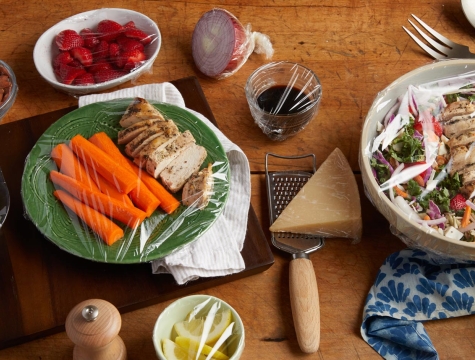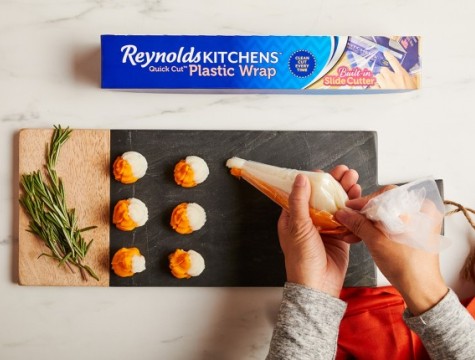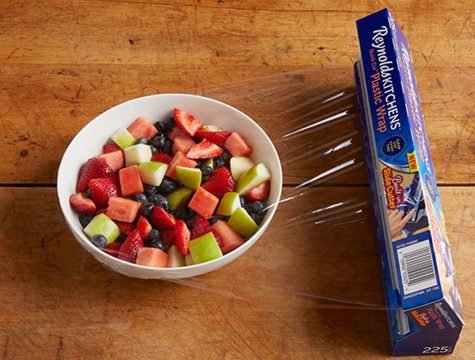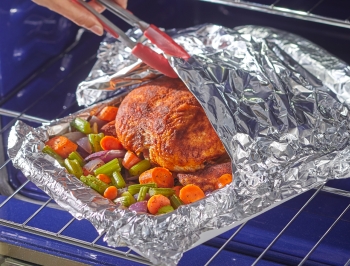The Ultimate Guide for Using Plastic Wrap for Food
From keeping your sandwiches fresh to sealing in the flavors of your favorite leftovers, plastic wrap is a must-have kitchen tool for keeping food fresh and preventing waste. Learn how to wrap, reheat, and store your food like a pro with plastic wrap.
Last updated: April 21, 2025
Is plastic wrap safe for food use?
When to use plastic wrap
Plastic wrap is an invaluable tool in the kitchen, but knowing when to use it can make all the difference in preserving the freshness and quality of your food. Let’s explore where plastic food wrap truly shines and when you should opt for other wraps or methods. It’s all about using it in the right places to keep your food tasting great and your kitchen safe.
Microwave
Can you microwave plastic wrap? Yes, but to get the best results and prevent the plastic from melting, always follow these guidelines:
- Cover microwave-safe containers with plastic wrap to reheat foods. Turn back one corner to vent steam.
- Always leave at least 1 inch between the wrap and the food. Heat for up to 3 minutes. Plastic wrap shouldn’t touch the food directly.
- Overheating foods with high fat or sugar content may melt wrap.
- Use caution when removing the plastic wrap from hot containers.
Freezer
Using plastic wrap in the freezer helps keep food fresh and protected until you’re ready to enjoy it. However, plastic wrap isn’t designed for use in the freezer alone. Instead, you should overwrap your plastic-wrapped foods with freezer paper or aluminum foil or place them in a freezer bag or airtight container.
How to wrap foods for the freezer
Tightly wrap your foods in plastic wrap while pressing out as much air as possible. Then, overwrap with freezer paper or aluminum foil. Learn how to wrap your foods in freezer paper for freezing.
Wrapping meat and leftovers for the freezer
Are you stocking up on meat to fill your freezer? Do you have leftovers you want to heat and eat later? Plastic wrap for freezing meat can help portion your food for easy, convenient freezing. Individually wrap raw chicken breasts, meat patties, or other meats in plastic wrap for manageable portions. Store slices of casseroles, burritos, baked goods, and other leftovers for easy reheating in the microwave (remove the wrap before heating). To prevent freezer burn, remember to double-wrap your portioned plastic-wrapped foods with freezer paper or aluminum foil.
Avoiding freezer-burned ice cream
Say goodbye to freezer-burned ice cream! Place a piece of plastic wrap over the container to prevent freezer burn before putting the lid on. This will help keep the air out and prevent ice crystals from forming.
Prepping sandwiches
A surprising storage technique for food—you can actually wrap sandwiches in plastic wrap and store them in the freezer! You can make sandwiches ahead for quick and easy lunches and quick meals. Common fillings that freeze well include nut butters, canned tuna and salmon, and cooked roast beef and chicken. Stack your meats on your desired bread. Wrap tightly with plastic wrap, cover single or multiple sandwiches with freezer paper or aluminum foil, and freeze. Once thawed, simply add your cheese, veggies, and toppings!1
Ovens and air fryers
Plastic wrap should not be used in conventional ovens, browning units, toaster ovens, or air fryers. These appliances are too hot for plastic wrap and will melt it. Parchment paper and aluminum foil are better for conventional oven use. We recommend using Reynolds Kitchens® Air Fryer Liners for easy cleanup in your fryer basket.
Stovetop and sous vide
Your stovetop can get super-hot, so using plastic wrap isn't safe. Melted plastic wrap can create a mess, spoil your food, and stick to your pots and pans. So, keep the plastic wrap away from the stovetop.
Can you use plastic wrap for sous vide cooking? Sous vide cooking involves cooking your food in a vacuum-sealed bag submerged in a low-temperature water bath for an extended period. Plastic wrap won’t fully seal your food, allowing water to seep in. This undermines the purpose of sous vide cooking. Plus, even at low water temperatures, the plastic could melt. It’s best to use cooking tools designed specifically for sous vide cooking.
Slow cookers and pressure cookers
You guessed it—plastic wrap shouldn’t be used in a slow cooker or pressure cooker because of the sustained heat. The heat can cause the plastic to melt and adhere to the food or the cooker. We recommend using our slow cooker liners, specifically designed to withstand the temperature of slow cookers.
How to use plastic wrap for cooking
Plastic wrap works wonders in the kitchen. Our plastic wrap for food with the slide cutter makes wrapping and storing easy! It provides easy dispensing and a nice, clean cut. You can use plastic wrap for food prep, cooking, and keeping leftovers fresh. Let's explore how to use plastic wrap for food to simplify your cooking and food storage needs.
You'll Need...
Plastic Wrap

Steaming vegetables
Steam your fresh or frozen vegetables quickly in the microwave—no need to break out a pot and a steamer basket. Add bite-sized pieces of vegetables to a microwave-safe bowl and add just enough water to cover the bottom of the dish. Cover the bowl with a piece of plastic wrap, ensuring that the wrap is about 1 inch above your veggies. Then, peel back a corner of the wrap to vent. Cook in 2-minute increments on high until your desired tenderness has been reached. The time required to steam vegetables will vary depending on the quantity of veggies you’re steaming and the thickness or density of the individual vegetable pieces.2

Covering large dishes and wrapping leftovers
Forming hamburger patties and storing meatballs
Want a less messy way to make hamburger patties? We’ve got you covered. Just grab a round, flat-bottomed bowl or container that matches the size of the patties you want to create. Line the container with a piece of plastic wrap. Press and flatten raw ground meat into the container to achieve your desired thickness. Then, fold the plastic wrap around the burger.3 It’s that easy! The burgers can be stored in the refrigerator for up to 2 days. For longer storage, stack and wrap them in freezer paper or aluminum foil. They will taste best if used within 4 months of freezer storage.4
Love your aunt’s recipe for homemade meatballs, but you don’t have time to cook them today? You can form meatballs a day ahead, place them on a tray, and cover them with plastic wrap to store in the refrigerator for up to two days.

Reheating leftovers in the microwave

Piping mashed potatoes, icing, or batter
Make a tasty twist on mashed potatoes using our plastic wrap hack for piping potatoes. Try this tip for icing or batter, too!

Preserving fruits and vegetables
Plastic wrap is an excellent way to keep fruits and vegetables fresh and tasty. Here are a few easy tips to help you make them last even longer!
- Apples, bananas, kiwis, oranges, pears, and pineapple: If you’ve partially eaten or used these fruits, wrap the remaining fruit in plastic wrap and store it in the refrigerator for a day or two.5
- Tomatoes and onions: Wrap unused halves tightly in plastic wrap and store in the crisper drawer, with the cut side down.6, 7
- Avocados: Remove the pit and skin, then squeeze lemon juice on the exposed portion and tightly wrap it in plastic wrap to help avoid browning. Place in an air-tight freezer bag and freeze.8
- Asparagus: Wrap the tip of the spears in plastic wrap to protect their crispness.8
- Cucumbers: Wrap them in plastic wrap and store them in the front of your fridge—the warmest part—because they prefer a slightly warmer environment than other vegetables. Don’t wash the cucumber until you’re ready to use it.9
Handling and tenderizing raw meat
Dealing with raw meat can sometimes be messy, but don’t worry. Plastic wrap can easily prevent cross-contamination with other foods and minimize the mess!
- Wrap raw meats tightly in plastic wrap to prevent meat juices from contaminating other foods or surfaces.
- When freezing meat and poultry in their original packaging, double-wrap the package with plastic wrap before covering it in freezer paper or aluminum foil.10
- When tenderizing meat with a mallet, place the meat between two sheets of plastic wrap to prevent splatters. (This keeps your cutting board cleaner, too!)
Wrapping cookies and baked goods
Plastic wrap is essential whether you’re wrapping individual cookies and bars for a bake sale, party, or school lunches. Like our delicious sugar cookies, takeaway snacks and treats stay fresher longer if tightly wrapped in plastic wrap. If you want to store the plastic-wrapped goodies in the freezer, wrap them in freezer paper or aluminum foil—they’ll stay tasty for a few months. For freezing pies, whole cakes, and bread, it’s best to wrap them tightly in plastic wrap to keep them moist and fresh, then add a layer of freezer paper or aluminum foil to prevent air or condensation from entering and causing freezer burn.11
Unexpected plastic wrap uses that go beyond cooking
Bet you didn’t know that plastic wrap can serve as a simple tablet protector, keep paint and flowers fresh, or help remove adhesive from glass containers. Explore other creative uses for plastic wrap!
Frequently Asked Questions
Is Reynolds Kitchens® Quick Cut™ Plastic Wrap microwave safe?
Reynolds Kitchens® Quick Cut™ Plastic Wrap, complies with FDA regulations for microwaving and is BPA-free, making it a reliable and versatile option for microwave use. Always follow the guidelines for safe use in the microwave: for safe use in the microwave:
- Cover a deep microwave-safe container or bowl with plastic wrap to reheat foods. Turn back one corner to vent steam.
- Leave at least 1 inch between the wrap and the food. Heat for up to 3 minutes.
- Overheating foods with high fat or sugar content may melt wrap.
- Use caution when removing the plastic wrap from hot containers.
Will plastic wrap melt in the microwave?
Is plastic wrap oven safe?
Does plastic wrap melt?
Can you freeze plastic wrap?
What to use instead of plastic wrap in the microwave?
Parchment paper and wax paper make for great alternatives when using the microwave! They can easily cover your dishes or be a handy protective layer below your dish to catch any spills or drips.
Related tips and how-tos:



Resources
- Freezing Sandwiches. University of Nebraska, Nebraska Extension UNL Food.
- Boyer, J. (2024, August 20). How to Steam Vegetables in the Microwave. WikiHow.
- Kapadia, J. (2017, July 7). How to Make Burger Patties. Food Republic.
- Ground Beef and Food Safety. USDA Food Safety and Inspection Service.
- (2022, June 23). How to Store Fruit So it Lasts as Long as Possible. Yahoo! Life.
- Fry, P. (2024, September 25). How to Store Tomatoes So They Don’t Get Mealy. Real Simple.
- Abraham, Lena. (2024, November 9). The Only Way to Prevent Half an Onion From Stinking Up Your Whole Refrigerator. Simply Recipes.
- Gold, B. (2023, April 23). The Secret to Storing Every Type of Fruit and Vegetable. Real Simple.
- Abraham, L. (2024, November 10). The 3 Reasons English Cucumbers Come Wrapped in Plastic. Simply Recipes.
- (2024, August 12). How Should You Wrap Meat for Refrigerating or Freezing? Ask USDA.
- Malloy, J. (2022, December 1). Why You Should Always Use 2 Layers of Wrapping to Freeze Baked Goods. Tasting Table.